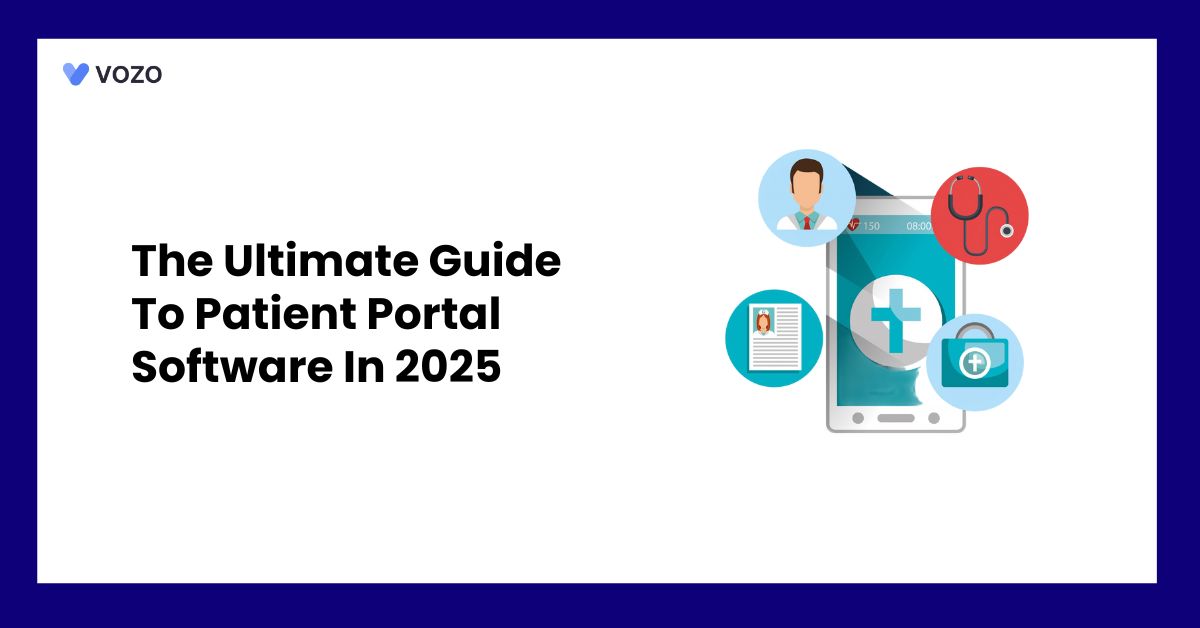The Ultimate Guide To Patient Portal Software In 2025
Patient portal software is an essential tech solution in healthcare practice because it changes how patients and doctors communicate. This portal streamlines administrative duties for healthcare professionals while enabling patients to manage their health data.
In this blog, you’ll learn the definition of patient portal software, its uses, and its benefits for providers and patients.
What is Patient Portal Software?
Patient portal software is an online platform that enables patients to access their health records, manage their prescriptions, make appointments, and interact with providers from the comfort of their own homes.
Patient portals connect with EHR systems, creating a centralized hub for patient involvement and administrative efficiency.
Uses for Patient Portal Software
Patient portal software performs several functions, improving the healthcare experience for both patients and providers.
- Access to Records – Patients can access medical information, including test results, prescription lists, vaccination records, and treatment plans, which allows them to make informed decisions.
- Appointment Scheduling – Patients may plan, reschedule, and cancel appointments online, decreasing wait times and administrative burdens.
- Prescription Management – Request prescription refills, receive medication reminders, and monitor adherence to treatment programs.
- Secure Messaging – Communicate directly with healthcare practitioners about non-urgent issues, minimizing the need for phone calls and in-person visits.
- Billing and Payments – View and pay medical bills online, create payment plans, and receive electronic statements.
Related: The Ultimate Patient Portal Checklist: What Every Healthcare Practice Needs
Why Patient Portals Matter in 2025
1. Increased Patient Engagement
Providing patients real-time access to their medical data promotes collaborative decision-making and self-management of chronic illnesses.
Portals will incorporate more elements, including interactive care plans, AI-driven health education material, and social determinants of health questionnaires, which will increase engagement.
2. Regulatory Compliance
The 21st Century Cures Act promotes interoperability and patient access, therefore, portals must use FHIR-based APIs and minimize information blocking.
Value-based reimbursement models link patient engagement measures, such as portal adoption rates, to incentive payments, making strong portal adoption a financial need.
3. Telehealth and RPM Integration
Telehealth is no longer optional, following the pandemic. Top patient portals will natively accept video visits, incorporate data from wearable devices, and produce alarms for out-of-range readings, allowing for proactive treatment and fewer hospital readmissions.
4. Data Analysis and Population Health
Advanced analytics dashboards inside portals enable healthcare organizations to detect high-risk groups, track adherence, such as drug refill trends, and classify populations based on social risk factors, resulting in targeted treatments.
Related: Top 5 Barriers To Patient Portal Adoption In 2025
Benefits for Patients and Providers
1. Enhanced Transparency & Access
Patients can access their lab results, treatment histories, and vaccination records. Confusions about prescriptions are reduced by the online visibility and actionability of medication lists and refill requests.
Providers no longer need to make follow-up calls when findings and visit summaries are distributed automatically. Administrative staff can concentrate on patient care when there are fewer phone calls regarding invoices or prescriptions.
2. Streamlined Communication
Patients can clarify their doubts may be answered securely and under HIPAA regulations via message, eliminating the need to contact the front desk.
Patients may initiate virtual visits with a single click thanks to integrated telehealth capabilities, which makes treatment easier, particularly for those who live in rural areas.
Missed or fragmented information is less likely when communication channels like messages, appointment notes, and lab feedback are centralized. By eliminating the need to move between programs, virtual visit integration enables physicians to maintain a consistent workflow.
3. Scheduling and Billing Convenience
Patients are given more control over their treatment schedule and fewer no-shows because of online appointment scheduling, rescheduling, and automated reminders. Using a patient portal, patients can view and pay invoices, promoting transparency around healthcare expenditures.
Providers can reduce front desk effort, and automated appointment reminders free up staff members to concentrate on providing in-person patient care. Real-time insurance eligibility checks and online payment solutions speed up revenue collection and reduce claim denials.
4. Data-Driven Clinical Efficiency
Patients can save time in the office by submitting medical histories, symptom checklists. More educated self-care is made possible by the ability to surface personalized educational information, such as articles, videos, and interactive tools, depending on individual situations.
Clinicians can expedite appointment cycles by reviewing important information such as vital signs, allergies, and chronic diseases before appointments. Proactive treatments for high-risk groups are made possible by aggregated patient-generated data that enters the EHR directly from RPM devices such as blood pressure cuffs and glucometers.
Related: Top 10 Features to Consider Before Choosing the Patient Portal
Vozo Patient Portal Solution
VOZO patient portal software provides a comprehensive solution to help healthcare providers achieve clinical, financial, and operational excellence through a powerful patient portal.
Our exceptional Patient Portal Software will allow:
- Have complete access to patients’ medical records digitally
- Our cost-effective subscription plan helps healthcare practices at all levels.
- The Vozo patient portal can effortlessly be integrated and implemented with any EHR system to increase productivity.
- Vozo’s Patient Portal respects users’ privacy and safeguards health-related records and personal information.
- 24/7 availability to support you with your needs and requirements.
- By understanding your unique needs for your specialty healthcare practice, we will customize Vozo’s patient portal for a seamless workflow.
Patients can request appointments, access health records and lab results, and even pay bills online with the help of a patient portal, which creates a personal touch with you always.
Leverage the Vozo Patient Portal for Better Healthcare Solutions.
About the author

With more than 4 years of experience in the dynamic healthcare technology landscape, Sid specializes in crafting compelling content on topics including EHR/EMR, patient portals, healthcare automation, remote patient monitoring, and health information exchange. His expertise lies in translating cutting-edge innovations and intricate topics into engaging narratives that resonate with diverse audiences.













